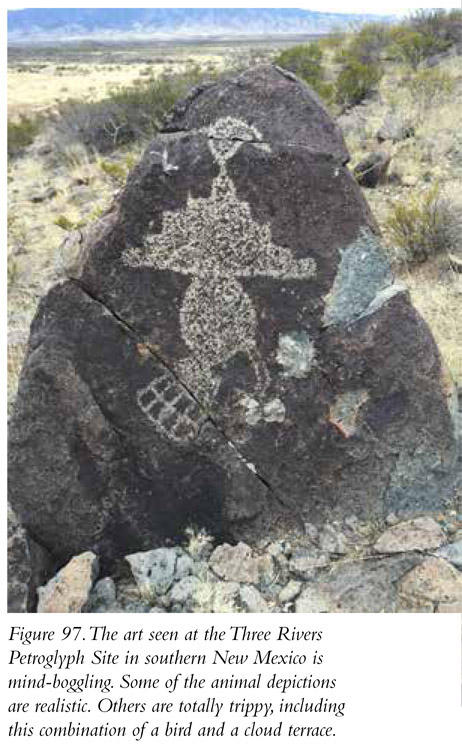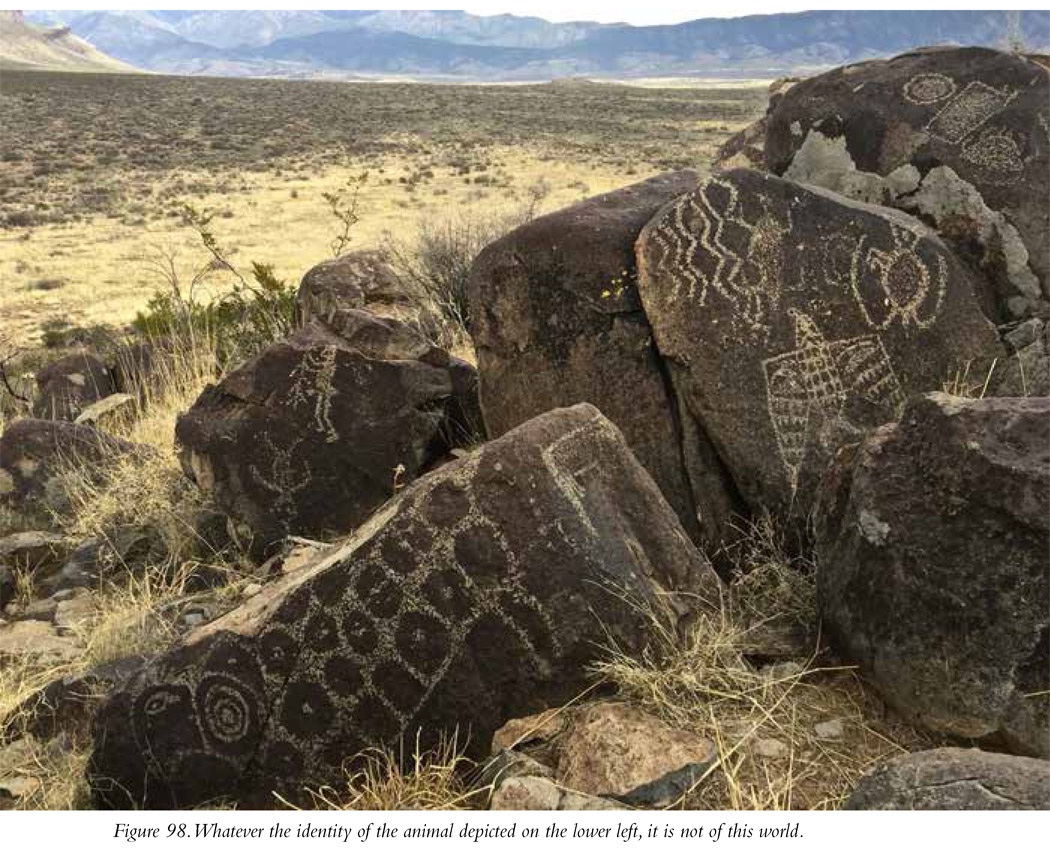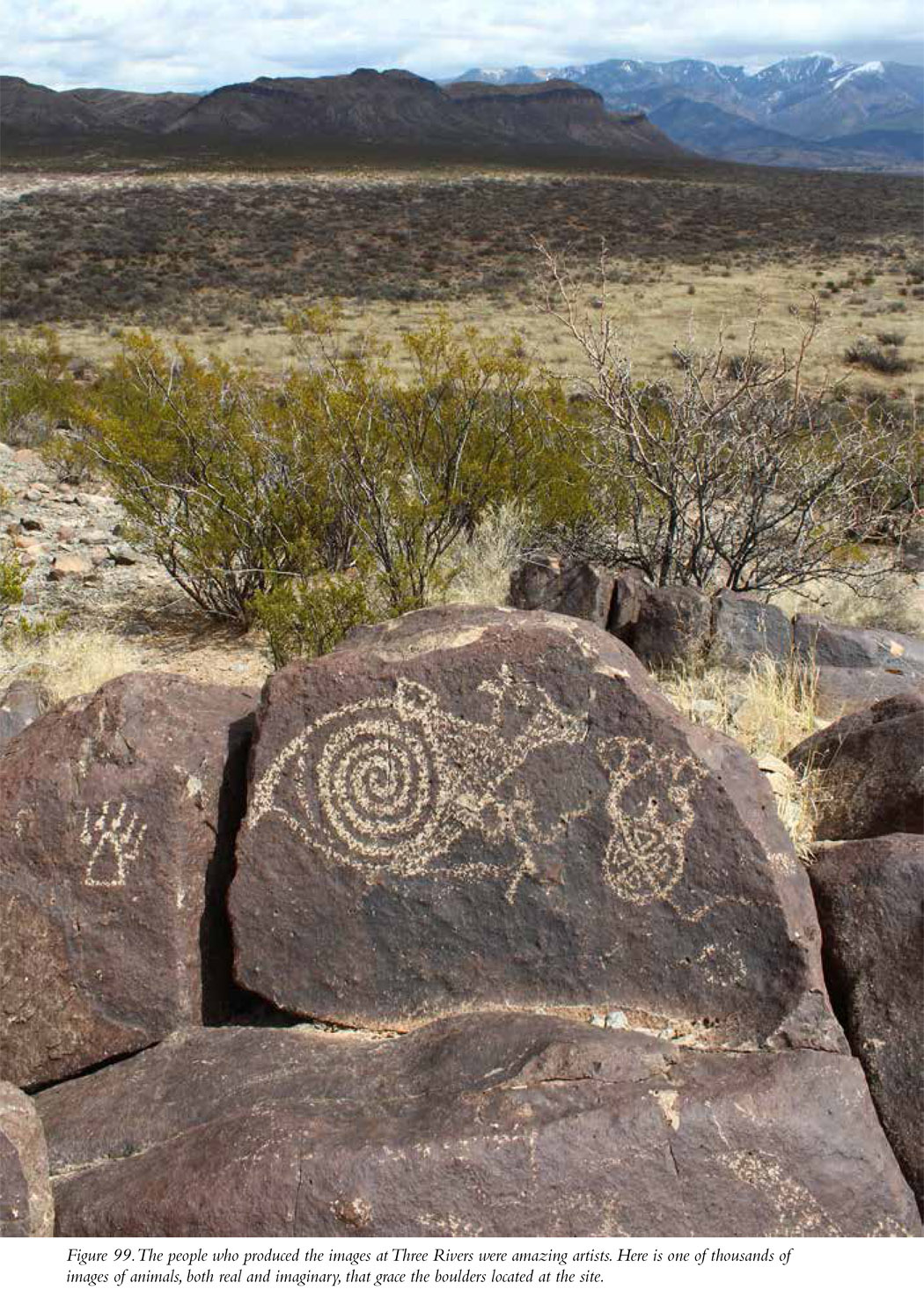
Tularosa, New Mexico
Journal Entry
June 19, 2014
When I began my archaeological odyssey in 2008, Three Rivers Petroglyph Site wasn’t on my radar. I had never even heard of it. Years before I had visited Petroglyph National Monument near Albuquerque and had been pretty impressed by the extensive and beautiful rock art there. No surprise; it was, after all, a designated national monument, one of only 109 in the United States, and one of the only such sites awarded that status as a result of its ancient rock art. I returned to Petroglyph National Monument in June 2014 to conduct a more intensive site visit expressly for this book. Then I drove south to see a few more sites for this and another project. After a careful perusal of Google Earth, and in a last-minute decision, I decided to make a brief stop at another rock art location, Three Rivers Petroglyph Site. I didn’t expect much. It’s not in a national park, it’s not listed as a national monument, nor is it listed as a national historical park. There’s no museum or gift shop. It’s just some Bureau of Land Management (BLM) property with a trail through it. I figured, hey, what the heck. It’s not too much out of my way; it is open to the public. I might as well give it a quick look, check it off my bucket list, maybe include it here as an “honorable mention.”
Ha! Three Rivers Petroglyph Site is mind-blowing, presenting about the densest concentration of astonishingly cool rock art I have seen during my journey through time. Three Rivers was so amazing that after a side trip to Carlsbad Caverns and Roswell (that’s another book!), I stopped again on my way back to Albuquerque to look at more of the art. And then I returned in spring 2015. And I want to go back again. I’m obsessed.
What You Will See
The Three Rivers site, like Petroglyph National Monument, presents a ton of rock art etched into the surfaces of large volcanic boulders. The BLM surveyed the art at Three Rivers and counted more than 21,000 separate and distinct images in the rocks. A very easy trail—a not-very-steep hike up to the volcanic ridge where most of the art is located—takes you into the midst of literally thousands of examples of rock art in the most intimate setting imaginable. The art isn’t up on a cliff or locked away behind a fence. It’s right there, directly in front of you, mostly at eye level or below. Some of it is amazingly fresh looking as a result of the density and durability of the volcanic basalt into which it has been etched, scratched, or pecked. There are myriad geometric designs, including circles and squares with intricate internal designs and plenty of sets of parallel zigzag lines. And there are animals, so many animals: bighorn sheep, lots of different kinds of birds, insects, snakes, lizards, fish, rabbits, an aardvark, and a coyote (Figure 97). Some of the animal images are surreal. Check out Figure 98. I have no idea what the animal on the lower left is supposed to be. The same is true for the critter in the center of the boulder in Figure 99. There also are handprints and footprints etched into the rock surface. And there are people, or at least images that look like people or humanlike spirit beings. Some are portraits of people. Some are in profile. Some are full-bodied people. A couple of the humanlike images bear a strong resemblance to the Mesoamerican rain god, Tlaloc (I.24). The southern New Mexico location of Three Rivers isn’t that far from the Mexican border, so it’s not surprising that religious ideas and gods may have migrated north of that modern, arbitrary border.

Some of the humanlike images are anatomically explicit males; and sorry guys, they have penises at least as long as their legs. Yikes! My favorite image is iconic of the site—a beautifully rendered bighorn sheep pierced by three arrows still attached to their shafts (I.25). Like many of the animal depictions at Three Rivers, the artist depicted this wounded bighorn with an intricately carved geometric design in its body.
The style of the art is identified as belonging to the Mogollon people, one of the groups who can today be traced to the modern Hopi Indians of the region. Rock art is notoriously difficult to date, and archaeologists usually rely on dated habitation sites near the rock art, especially if we find art of a style similar to the petroglyphs on pottery or in the form of figurines found near datable charcoal (like the Pilling Figurines I discussed earlier). On this basis, the rock art at Three Rivers has been dated to a 500-year period between AD 900 and AD 1400.


The main trail follows the top of the volcanic ridge, but you’ll want to take lots of the short side trails among the boulders to see as much of the art as you can. The main trail takes you to an arched, covered shelter with benches located only about 0.5 mile from the parking lot; you’ll appreciate that shelter in the heat. If you stop here and turn back to the parking lot, you will have seen a lot of the art, but not all of it. The trail continues beyond the shelter, and some of the coolest art is farther along on the trail. It’s up to you, but I highly recommend continuing on and seeing as much of the art as you can.
The main trail follows the basalt ridge. But for the whole experience, you also need to walk the base of the east margin of the ridge. There’s lots more art there. Figure 1 is a photograph of a petroglyph located at the base of the ridge.
Because of the context of the art, Three Rivers is an especially great place to bring kids, even pre-teens. The art is just so accessible on so many levels; much of it is at eye level or below, even for a kid. It’s all over the place, secreted behind boulders, hidden around corners, and tucked away in niches; it’s actually easier for a kid to reach some of the art than for an adult. Finding cool art panels and pointing them out to their parents can be a fun activity. Be aware that the igneous rock that characterize the ridge is hard and can have sharp-edged corners, so scampering around between boulders affords the potential for cuts and scrapes. With some care taken, kids can have a blast; but always remind them, no matter how cool the art looks, no touching!
Why Is Three Rivers Important?
Certainly there are lots of formal, technical reasons Three Rivers is an important site. But for me, all those reasons are embedded in the same explanation: It’s all about the art. In all honesty, that reason alone is reason enough to visit this site.
Archaeologists want to be able to explain the past, to understand the cultures and even the minds of past peoples. It’s in our job description; it’s in our DNA. The art produced by ancient people screams out for interpretation, for explanation. Were ancient people merely documenting what they saw during their lives? Was it hunting magic, an attempt to ensure success in the hunt by capturing the spirit of the animals on a two-dimensional canvas of stone? Was it a form of worship, a way of honoring the spirits represented in the art? Were the images painted on or etched into rock surfaces all over the world in antiquity representations of hallucinations experienced by the artists as the result of ingesting psycho-tropic substances or just due to fasting or intentional sleep deprivation? Did they interpret what we call hallucinations as a window into another world or another reality? It is difficult to say with any certainty. Accepting that uncertainty, however, in no way detracts from how incredibly cool the art is.
I’m perfectly okay with viewing the art at Three Rivers as a result of simply the very human need to produce it. No matter what the other specific cultural reasons may be for what the artists at Three Rivers produced—and whether we will ever be able to figure those reasons out—I’m guessing that artists stepping back to view their work thought to themselves, Damn! That’s good! And it’s damn good that today, centuries later, we can hear the echoes of that self-review reverberating among the volcanic boulders that were the canvases of those prolific artists.
Additional Note
Let’s face it; Three Rivers Petroglyph Site is in the middle of nowhere. I suppose that’s one reason it’s not Three Rivers Petroglyph National Monument, with a museum, gift shop, slick four-color brochure, and terrific website. No matter. It is more than worth the 3-hour trip from Albuquerque.
Site Type: Petroglyphs
Wow Factor: ***** Amazing is the only appropriate word for the rock art located at Three Rivers. You’ll be blown away by its beauty.
Museum: None, but there is a small building where the site managers often are available for guidance.
Ease of Road Access: ****
Ease of Hike: ***
Natural Beauty of Surroundings: **** The site is located in the midst of a stark, volcanic landscape.
Kid Friendly: *****
Food: Bring your own.
How to Get There: From the north, take US 54 south from Carrizozo, New Mexico, to CR B30, which will be on your left in about 26 miles. From the other direction, drive north on US 54 from Tularosa, New Mexico, for a bit more than 17 miles. CR B30 is located on the right. A sign at the intersection of US 54 and CR B30 directs you toward the site, and there’s a little store on the north side of the intersection. Once you turn east onto CR B30, you’ll cross railroad tracks and it’s a 5-mile drive on a paved road to the parking lot, on your left.
Hours of Operation: Open 8 a.m. to 7 p.m. April to October; 8 a.m. to 5 p.m. October to April
Cost: See website.
Best Season to Visit: It’s crazy hot in southern New Mexico in summer (but it’s a dry heat—like that makes it easier to take when it’s 115°F). There’s zero shade for most of the trail.
Website: www.blm.gov/nm/st/en/prog/recreation/las_cruces/three_rivers.html
Designation: Bureau of Land Management property